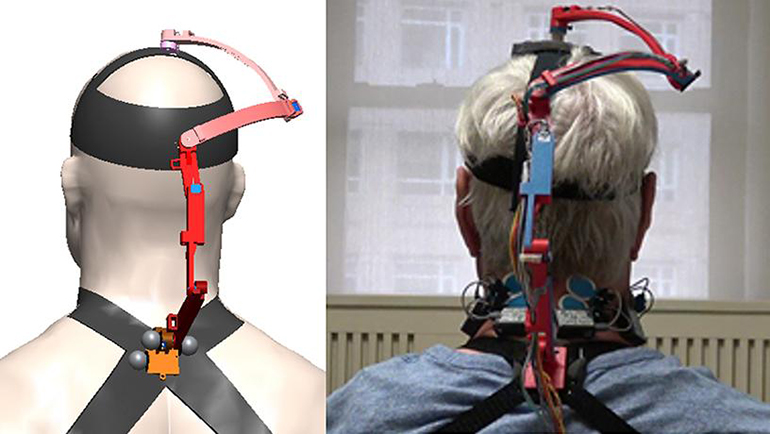

Patients with head and neck cancer frequently require surgical removal of lymph nodes from the neck. While this is necessary, it can cause pain and stiffness that can persist for a long time after surgery. Assessing neck mobility of such patients would be useful, as it would allow doctors to identify deficits in range of motion, and design appropriate strategies to help improve them.
However, current techniques to achieve this are somewhat crude and do not produce quantifiable data, or involve equipment that is not easily portable or easy to use, making routine clinical assessments challenging.
Researchers have now developed a portable robotic neck brace that can measure neck mobility in patients who have undergone treatment for head and neck cancer.
The device uses 3D-printed parts and simple sensors to measure neck and head movement, and could help clinicians to understand the impact of surgical interventions and help them design a treatment regimen to improve neck mobility. The device is portable and easy to use, making it more accessible for routine use.
“This is the first study of this kind where a wearable robotic neck brace has been designed to characterize the full head and neck range of motion,” said Sunil Agrawal, a researcher involved in the study.
The new brace is based on a similar design that the researchers used to measure neck movements in patients with amyotrophic lateral sclerosis.
The team tested the new brace in five cancer patients so far and used it, along with measurements of muscle electrical activity in the neck, to test neck mobility before and after surgery to remove lymph nodes from the neck.
“Use of the sensing neck brace allows a surgeon to screen patients postoperatively for movement difficulty, quantify their degree of impairment, and select patients for physical therapy and rehabilitation,” said Scott Troob, another researcher involved in the study.
“Patients consistently identify need for rehabilitation and guided exercises after surgery as an unmet need in their medical care. This work will lay the foundation for the appropriate identification of patients for intervention. We additionally hope that through using the neck brace, we will be able to objectively quantify their improvement and develop evidence-based rehabilitative programs.”
more recommended stories
 Safer Allogeneic Stem Cell Transplants with Treg Therapy
Safer Allogeneic Stem Cell Transplants with Treg TherapyA new preclinical study from the.
 Autoimmune Disorders: ADA2 as a Therapeutic Target
Autoimmune Disorders: ADA2 as a Therapeutic TargetAdenosine deaminase 2 (ADA2) has emerged.
 Kaempferol: A Breakthrough in Allergy Management
Kaempferol: A Breakthrough in Allergy ManagementKaempferol, a dietary flavonoid found in.
 Early Milk Cereal Drinks May Spur Infant Weight Gain
Early Milk Cereal Drinks May Spur Infant Weight GainNew research published in Acta Paediatrica.
 TaVNS: A Breakthrough for Chronic Insomnia Treatment
TaVNS: A Breakthrough for Chronic Insomnia TreatmentA recent study conducted by the.
 First-of-Its-Kind Gene-Edited Pig Kidney: Towana’s New Life
First-of-Its-Kind Gene-Edited Pig Kidney: Towana’s New LifeSurgeons at NYU Langone Health have.
 Just-in-Time Training Improves Success & Patient Safety
Just-in-Time Training Improves Success & Patient SafetyA study published in The BMJ.
 ChatGPT Excels in Medical Summaries, Lacks Field-Specific Relevance
ChatGPT Excels in Medical Summaries, Lacks Field-Specific RelevanceIn a recent study published in.
 Study finds automated decision minimizes high-risk medicine combinations in ICU patients
Study finds automated decision minimizes high-risk medicine combinations in ICU patientsA multicenter study coordinated by Amsterdam.
 Study Discovers Connection Between Omicron Infection and Brain Structure Changes in Men
Study Discovers Connection Between Omicron Infection and Brain Structure Changes in MenA recent study in the JAMA.

Leave a Comment